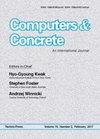Improving the seismic performance of reinforced concrete frames using an innovative metallic-shear damper
IF 3.3
4区 工程技术
Q2 COMPUTER SCIENCE, INTERDISCIPLINARY APPLICATIONS
引用次数: 2
Abstract
In reinforced concrete (RC) frames, the applied seismic energy is dissipated through the ductile behavior of RC moment resisting frames. The main elements of the RC frames carry the gravity loads in addition to the seismic loads. Since the RC frames are sensitive to gravity loads, the ductility of the frames is reduced by increasing the gravity loads. Moreover, because of the low stiffness of the RC moment frames, huge member sizes of structural elements are required to control lateral drifts under lateral loading. In addition, the existing RC moment frame buildings with non-ductile characteristics pose a considerable hazard during earthquakes. To solve the mentioned problems, an innovative metallic damper with a shear link (metallic-passive energy damper) was developed in this paper. The proposed damper not only enjoys an easy fabrication and a good seismic performance but also can be easily replaced after a severe earthquake. Since the damper does not carry the gravity loads, replacing the damper does not affect the severability of the building during repairing. The main goal of this study is to confine the plastic deformation in the proposed damper. The numerical results indicated that the proposed damper improved the behavior of the RC frame in elastic and inelastic zones. It enhanced the shear capacity, shear stiffness, energy absorption, and ductility of the RC moment resisting frame. The results indicated that the proposed damper enhances the shear stiffness and the ultimate shear capacity from a minimum of 11% to a maximum of 24% and from a minimum of 11% to a maximum of 48%, respectively. Also, the proposed damper improved the yielding strength from a minimum of 53% to a maximum of 61%. Moreover, the dynamic analysis indicated that the damper improved the behavior of the system in the case of maximum lateral displacement and base shear. Based on the time-history dynamic analysis, dampers in the 5- and 10-story frames are more effective compared to the 15-story frame. This result confirms the suitable performance of the proposed damper. Herein the required equations and the recommendations for the design of the proposed metallic-shear damper have been presented.采用新型金属剪力阻尼器改善钢筋混凝土框架的抗震性能
在钢筋混凝土框架中,施加的地震能通过钢筋混凝土抗弯矩框架的延性特性来耗散。钢筋混凝土框架的主要构件除承受地震荷载外,还承受重力荷载。由于钢筋混凝土框架对重力荷载很敏感,增加重力荷载会降低框架的延性。此外,由于钢筋混凝土弯矩框架的刚度较低,控制横向荷载作用下的横向位移需要巨大的构件尺寸。此外,现有的钢筋混凝土弯矩框架结构具有非延性特征,在地震中构成相当大的危险。为了解决上述问题,本文提出了一种新型的带剪切连杆的金属阻尼器(金属被动能量阻尼器)。所设计的阻尼器不仅制作简单,抗震性能好,而且在剧烈地震后也易于更换。由于减振器不承担重力载荷,因此在修复过程中更换减振器不会影响建筑物的可分割性。本研究的主要目的是限制所提出的阻尼器的塑性变形。数值结果表明,该阻尼器改善了钢筋混凝土框架在弹性区和非弹性区的性能。提高了钢筋混凝土抗弯矩框架的抗剪能力、抗剪刚度、吸能和延性。结果表明:该减振器将抗剪刚度和抗剪承载力分别从最小11%提高到最大24%和从最小11%提高到最大48%;此外,所提出的阻尼器将屈服强度从最小的53%提高到最大的61%。此外,动力分析表明,阻尼器改善了系统在最大侧向位移和基底剪切情况下的性能。基于时程动力分析,5层和10层框架的阻尼器比15层框架的阻尼器更有效。这一结果证实了所提出的阻尼器的适当性能。文中给出了所需的方程和所提出的金属剪切阻尼器的设计建议。
本文章由计算机程序翻译,如有差异,请以英文原文为准。
求助全文
约1分钟内获得全文
求助全文
来源期刊

Computers and Concrete
工程技术-材料科学:表征与测试
CiteScore
8.60
自引率
7.30%
发文量
0
审稿时长
13.5 months
期刊介绍:
Computers and Concrete is An International Journal that focuses on the computer applications in be considered suitable for publication in the journal.
The journal covers the topics related to computational mechanics of concrete and modeling of concrete structures including
plasticity
fracture mechanics
creep
thermo-mechanics
dynamic effects
reliability and safety concepts
automated design procedures
stochastic mechanics
performance under extreme conditions.
 求助内容:
求助内容: 应助结果提醒方式:
应助结果提醒方式:


